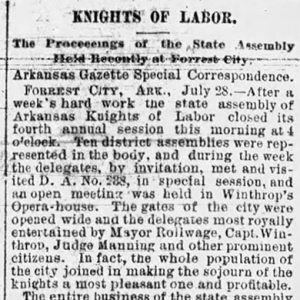calsfoundation@cals.org
Dan Fraser Tomson (1850–1924)
A native of Tennessee, Dan Fraser Tomson helped organize—and was a charter member of—the first local assembly (or lodge) of the Knights of Labor in Arkansas. He also served as a state organizer and lecturer and, eventually, as the Knights’ highest-ranking state officer. In addition, he edited a weekly newspaper, the Industrial Liberator, which served as the official organ of the Arkansas Knights of Labor, and he became a significant figure in the national Knights of Labor organization. He served in a variety of military- and government-related jobs throughout his life, including as a clerk in Washington DC, copying the Civil War records of Missouri soldiers; a staff member in the Missouri Senate; and a clerk in the Missouri adjutant general’s office.
Dan Tomson was born on April 23, 1850, in Hardeman County, Tennessee, the fifth child of Thomas Arrington Thompson and Kerrenhappuck Sellars Thompson. (By the time he had reached adulthood, Dan Fraser Tomson had adopted the practice of other members of his family of dropping the “h” and “p” from the spelling of his surname, since they were silent.) The family moved to Miller County, Missouri, in 1860. At some point between mid-1864 and early 1865, Tomson enlisted in the Union army; the young teenager served as drummer boy. He would later become active in the Grand Army of the Republic.
He worked as a ward master at a U.S. Marine hospital in St. Louis, Missouri, in 1871. On January 17, 1872, he married Elizabeth Catherine Melton, with whom he would have five children.
By the early 1880s, Tomson and his family had moved to Hot Springs (Garland County). Tomson engaged in farming, and, in late 1882, he helped establish the first Arkansas local assembly (Hot Springs Assembly 2419) of the Knights of Labor. The national organization had been founded in Philadelphia, Pennsylvania, in 1869 and claimed more than 700,000 members across the United States by 1886. Tomson also helped organize the state’s second Knights local assembly, Freedom Assembly 2447 (also of Hot Springs), which consisted entirely of African Americans. In 1883, Tomson represented the Hot Springs local assemblies at the national Knights of Labor General Assembly convention in Cincinnati, Ohio, and he would later represent the Arkansas State Assembly of the Knights of Labor, which was formed in 1886, at these annual national Knights conventions.
By 1884, Tomson was corresponding with the leaders of two farmers’ organizations in Arkansas, the Agricultural Wheel and the Brothers of Freedom, in an effort “to turn these bodies into the K. of L.,” as he informed national Knights leader Terence V. Powderly. While Tomson did not succeed in absorbing these larger organizations into the Knights of Labor, the Arkansas Knights’ peak membership of over 5,000 by 1887 included many farmers, as well as industrial laborers such as railroad workers and miners. The Knights and the Agricultural Wheel both figured prominently in the formation of the Arkansas Union Labor Party in 1888. Tomson himself ran unsuccessfully, at the urging of his fellow Knights, for the Arkansas General Assembly on a “working man’s” ticket in 1884, but he later proved wary of tying the Knights too closely to partisan politics, in keeping with the organization’s official (though often violated) nonpartisan stance.
In 1886, when the Arkansas Knights of Labor formed a statewide organization (State Assembly), it appointed Tomson as state organizer, and he moved to Little Rock (Pulaski County). There, he became the first editor of the Knights’ cooperatively owned newspaper, the Industrial Liberator. The Knights became involved in two noteworthy strikes in Arkansas that year—a strike known as the Great Southwest Railroad Strike and a strike by African-American farmhands on a plantation in Pulaski County. Tomson served as an intermediary in the latter strike. Though the strike failed, Tomson expressed support for the strikers in the Industrial Liberator and helped ensure that the strike ended without bloodshed, in sharp contrast to a cotton pickers’ strike led by the Colored Farmers’ Alliance in Lee County five years later that resulted in approximately twenty deaths.
From 1888 to 1890, Tomson served as the State Master Workman of the Arkansas Knights of Labor, but the organization had begun a slow decline in the state that would be complete by the end of the 1890s. Tomson—by this time living in Tuscumbia, Missouri—attended the Knights’ General Assembly convention in Denver, Colorado, in 1890, and delivered an address.
He spent the remainder of his life in Missouri, working as a farmer, a journalist, and a clerk in the adjutant general’s office. He died on December 31, 1924, in Equality, Missouri.
For additional information:
Case, Theresa A. The Great Southwest Railroad Strike and Free Labor. College Station: Texas A&M University Press, 2010.
Hild, Matthew. Arkansas’s Gilded Age: The Rise, Decline, and Legacy of Populism and Working-Class Protest. Columbia: University of Missouri Press, 2018.
———. Greenbackers, Knights of Labor, and Populists: Farmer-Labor Insurgency in the Late-Nineteenth-Century South. Athens: University of Georgia Press, 2007.
———. “Labor, Third-Party Politics, and New South Democracy in Arkansas, 1884–1896.” Arkansas Historical Quarterly 63 (Spring 2004): 24–43.
Miller County Museum & Historical Society. Progress Notes, May 12, 2008, and July 18, 2011. http://www.millercountymuseum.org/archives/080512.html and http://www.millercountymuseum.org/archives/110718.html (accessed November 24, 2020).
Phelan, Craig. Grand Master Workman: Terence Powderly and the Knights of Labor. Westport, CT: Greenwood Press, 2000.
Matthew Hild
Georgia Institute of Technology
 Civil Rights and Social Change
Civil Rights and Social Change Labor Movement
Labor Movement Post-Reconstruction through the Gilded Age, 1875 through 1900
Post-Reconstruction through the Gilded Age, 1875 through 1900 Tate Plantation Strike of 1886
Tate Plantation Strike of 1886 Knights of Labor Story
Knights of Labor Story  Knights of Labor Story
Knights of Labor Story 



Comments
No comments on this entry yet.